Every week, I get an email from Netflix that alerts me to a new series (or a new documentary) that I might like based on my previous viewing choices.
The mobile app, Bandsintown, periodically sends me push notifications based on my musical tastes. It lets me know when bands I might want to see will be touring in my area.
Spotify automatically creates “Daily Mix” and “Discover Weekly” playlists just for me. I listen to them on my long drive to work.
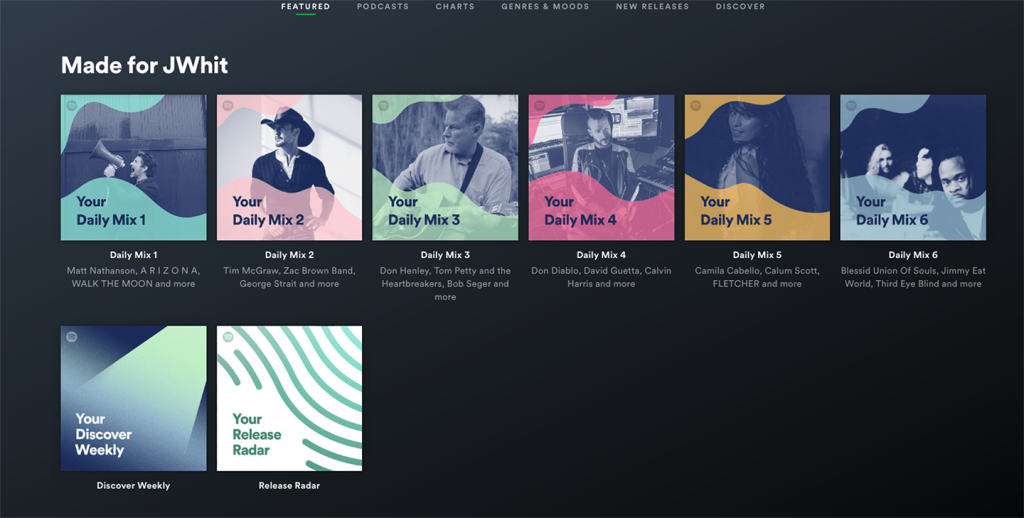
I LOVE each and every one of these brands.
Why? The answer is that I love them for several reasons.
- They save me time.
- They make my life easier and more enjoyable.
- Most of all: they make their interactions with me personal.
It’s important to note that none of these brands would be able to deliver tailored suggestions to me without the existence of artificial intelligence (in one form or another).
Without AI, I may have never stumbled upon the Netflix series, Mindhunter. Or, I could have missed the Stevie Nicks concert that I went to two years ago.
Or, even worse, I could be driving to work desperately flipping through music channels instead of paying attention to the road.
AI is present and integral in our lives more than many people realize. And, its role in our relationships with our favorite brands is only expected to grow.
By 2020, AI automation will manage 85% of companies’ customer relationships. @Gartner_inc Share on XBy 2020, AI automation will manage 85% of companies’ customer relationships (Gartner).
Here are 5 ways AI is currently being used to personalize customers’ experiences and what we can expect to see in the future as technology advances.
1. AI-Generated Personalized Content
As I highlighted with my own experiences above, AI allows companies to intuitively deliver personalized suggestions to consumers based on their behavior and preferences.
Amazon is another brand that has found great success by consistently presenting its customers with products that are relevant to their needs and interests.
How do they do it?
By utilizing AI to track visitors’ browsing and purchase trends, and continually placing individualized suggestions in front of shoppers.
For example, Amazon welcomes website visitors with AI-generated recommendations.
Every registered customer arrives on the retailer’s website to find their own customized dashboard . Similarly, brands are also beginning to leverage AI UGC to personalize shopping experiences by automatically curating authentic user-generated content, tailored to individual interests and behaviors. (just like the one below).
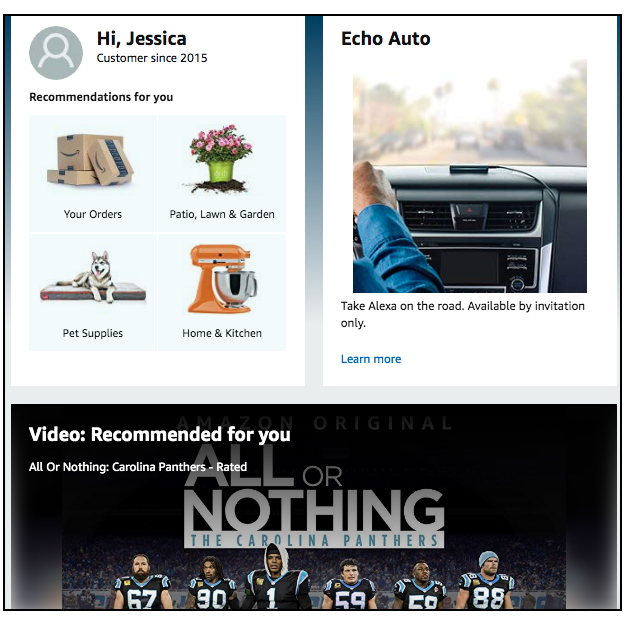
Statistics show that these types of personalized features increase consumer spending and loyalty.
78% of U.S. Internet users said personally relevant content from brands increases their purchase intent and 87% of consumers surveyed said that personally relevant content positively influences how they feel about a brand (Instapage).
78% of users said personally relevant content increases their purchase intent and 87% of consumers said that personally relevant content positively influences how they feel about a brand. @Instapage Share on XObviously, AI-generated content isn’t the sole reason Amazon is so lucrative. But, it plays a major part in allowing Amazon to provide its customers with an experience they love.
2. Automatic Delivery of Proactive Greetings and Reminders
Before the end of 2020, 51% of consumers will expect that companies anticipate their needs and make relevant suggestions before they make contact (Salesforce).
Before the end of 2020, 51% of consumers will expect that companies anticipate their needs and make relevant suggestions before they make contact. @SFResearch #customerexperience Share on XRelated Post: How to Provide Proactive Customer Service
AI proactive greetings and reminders are now being used to accomplish both of these feats by way of live chat and SMS messaging.
Live Chat Greetings
For instance, intelligent live chat software has become advanced enough to collect and store detailed website visitor information.
It’s also used to track and interpret customers’ geolocations, prior website visits, browsing histories, and present webpage views (if they are currently browsing your site).
This information is then compiled and used to configure chat triggers (i.e. pre-written chat messages that are delivered automatically based upon set visitor behavior conditions).
For example, the live chat window pictured below has recognized that someone is browsing LiveHelpNow’s pricing page. It then greets them accordingly.
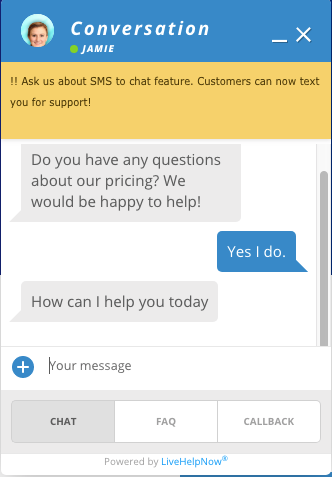
Companies can even program their chatbots to inquire if a consumer is interested in learning more about a product that they viewed during a previous visit.
Related Post: 20 Ways to Make Live Chat Personal
SMS Reminders
Businesses are also having success with proactive AI-generated text message updates and reminders.
85% of consumers are interested in receiving proactive notifications, and an astounding 90% say they’re more likely to do business with a company that sends reminders. @NuanceEnt Share on XAccording to research conducted by Nuance, 85% of consumers are interested in receiving proactive notifications, and an astounding 90% say they’re more likely to do business with a company that sends reminders.
Have you ever received an SMS from your phone service provider letting you know you are nearing the limits of your data plan? Or, have you ever been texted an appointment reminder from your doctor’s office?
Here’s an example of an SMS reminder I received from Suburu dealership regarding a scheduled test drive:

Sometimes messages like these can really save the day.
3. AI Targeted Email Offers and Promotions
We all get them…the dreaded, mass-produced marketing emails. Ugh.
The good news is that AI is making it possible for brands to send individually curated emails to their customers, and it’s changing the promotional email game for the better.
The same messages that used to be an annoyance inevitably bound for the virtual trash bin are actually becoming useful.
Case and point: I recently bought a new Keurig coffee machine. A few days later, I received an email from the retailer to alert me that they were having a sale on K-cups.
Admittedly, this AI-generated email actually worked. Two boxes of Classic Cinnamon Roll K-cups later, and I was on my merry way.
75% of consumers are more likely to buy from a retailer that recognizes them by name, recommends options based on past purchases, OR knows their purchase history. @Accenture Share on XA recent study conducted by Accenture found that 75% of consumers are more likely to buy from a retailer that recognizes them by name, recommends options based on past purchases, OR knows their purchase history.
AI is also being used to track and react to customers’ life events, like birthdays and anniversaries.
Intelligent software then utilizes this collected information to send consumers individualized special offers.
For example, the Philadelphia Phillies send out birthday emails to registered fans that offer $8 MLB tickets with the use of their birthday promo code.
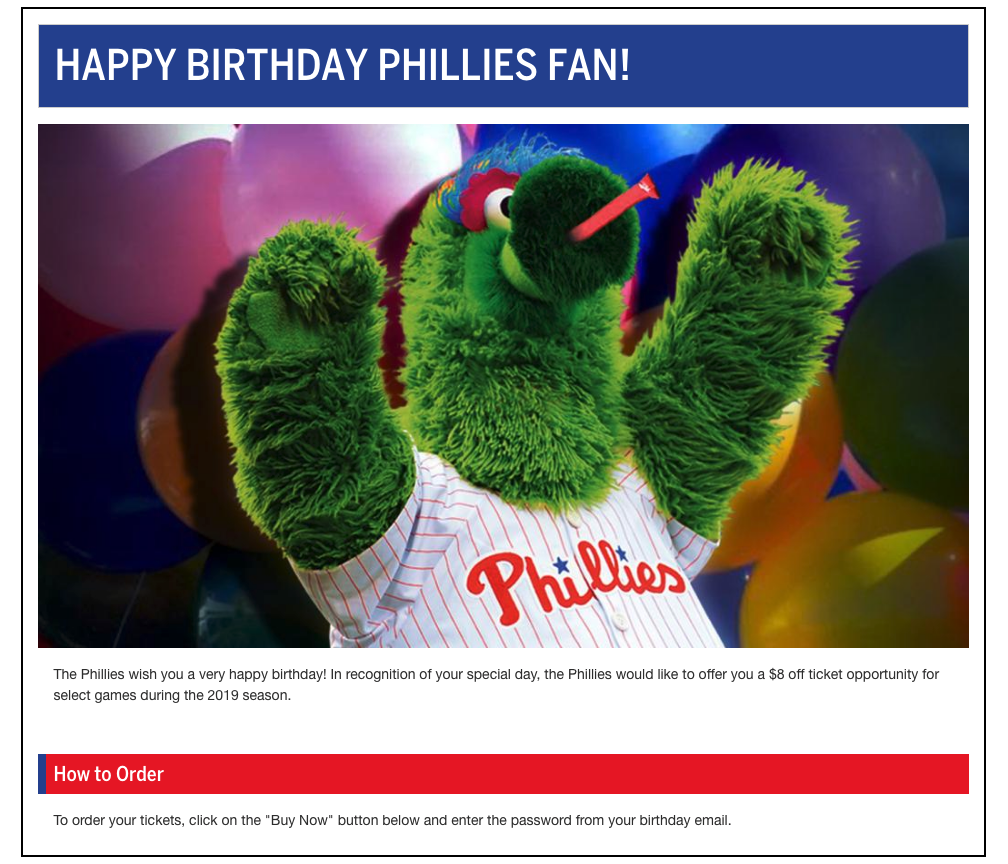
These types of efforts not only boost sales, but they make customers feel recognized and appreciated during important milestones.
I know I’d be excited to scream “Take Me Out to the Ballgame!” for $8.
4. AI-Powered Predictive Task Completion
Predictive personalization is by far one of the most captivating and impressive trends to emerge in recent years
Empowered by AI, brands now have the capacity to predict consumers’ behavior, needs, and wants.
They also have the capability to create tangible products that can intuitively satisfy those needs and wants.
Smart Appliances
For example, companies like Samsung are using machine-learning software to develop devices that independently complete precise tasks.
One such product is Samsung’s Family Hub 4.0 refrigerator.
The Family Hub fridge has built-in technology that sends users alerts about expiring food. It then offers recipes that include the soon-to-be expired groceries through a Meal Planner app.
In addition, the fridge’s Instacart app allows users to order groceries. The ordered items are then delivered directly to the customer’s home within an hour.
Self-Driving Cars
The virtual assistant trend is beginning to reach far beyond our kitchens.
It’s also starting to appear on America’s highways and byways.
For instance, vehicle innovators at Tesla have installed mapping software that does far more than just tell a driver how to get to their destination. This AI is trained on countless hours of video data, such as stop signs, traffic lights, pedestrians and more, which have been labeled using a video annotation tool.
If you’re not in the mood to drive, Tesla’s AutoPilot feature will tell the car where to take you.
You won’t have to worry about being later either. The car will check your calendar before it drives you to your scheduled appointment.
5. Data Unification from Multiple Touchpoints
These days companies are tweeted at, texted, inboxed, DM-ed, instant messaged, voice-called, and @ mentioned.
Just thinking about the barrage of requests, inquiries, and feedback a brand receives on a daily basis can make your head spin.
It’s a customer service war zone out there.
This touchpoint graphic from Branding For The People pretty much sums up the chaos:
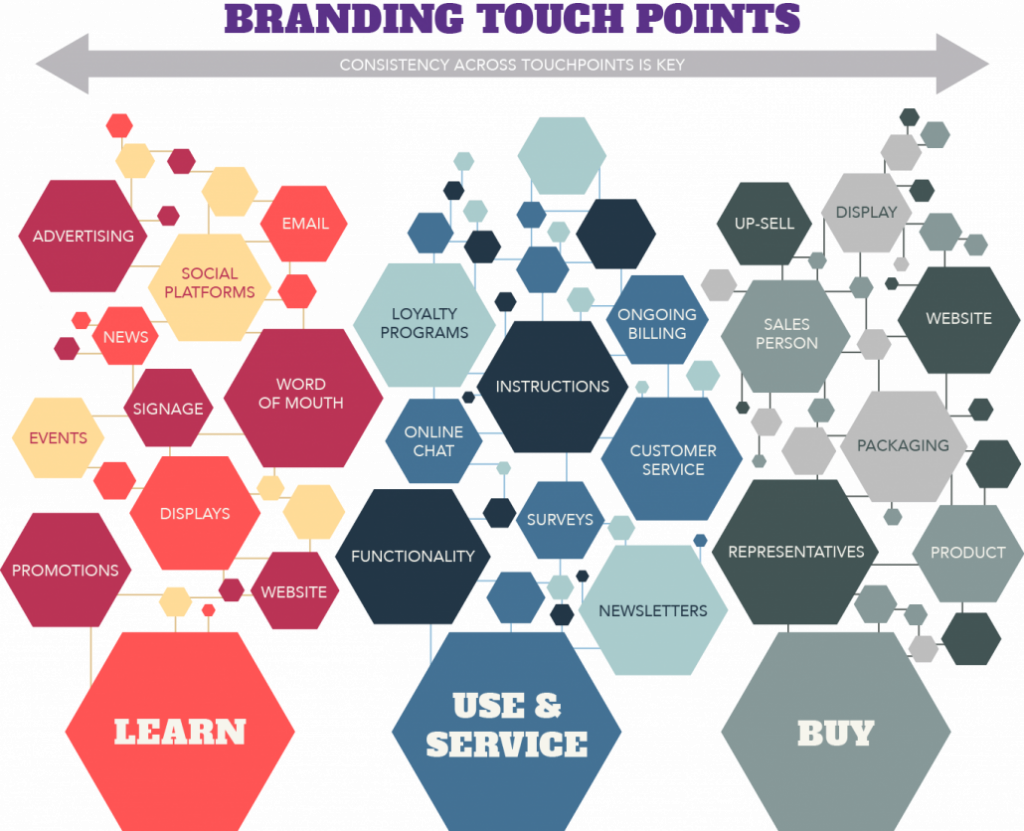
And, with all that customers have on their mind in this fast-paced world, they aren’t exactly forgiving.
They want a fast, accurate, consistent experience regardless of the medium they are contacting you from.
According to a Customer Experience Benchmark study conducted by NICE, 72% of customers expect companies to know their purchase history regardless of what method of communication they used, such as chat, phone or email.
72% of customers expect companies to know their purchase history regardless of what method of communication they used, such as chat, phone or email. @NICELtd Share on XThankfully, intelligent insights and centralized data management systems have made it possible to track and log customer data in real-time across multiple touchpoints.
Before the existence of AI, compiling massive amounts of data into individualized customer profiles would have taken weeks…maybe even months.
Today, large corporations like General Electric, Toyota and HP use AI-powered data unification software like Tamr to instantly organize and store customer data for quick access.
This allows their customer service teams to offer a streamlined, personalized experience from any touchpoint.
For example, if a customer gets disconnected from a voice call due to a bad connection, the live chat agent they speak to later will have a record of phone inquiry. The conversation can then pick up where it left off.
Easy-peasy. No fuss. No muss.
Having data collected from outsourced live chat support teams serves as an invaluable resource in curating AI outcomes.
The Future of the AI Customer Experience
When it comes to the future of AI and the customer experience, two things are certain:
1. AI isn’t going anywhere.
-
- More than 40% of all data analytics projects will relate to customer experience by 2020. (Source: Gartner)
- The AI market is projected to become a $190 billion industry by 2025. (Source: Markets and Markets)
2. Customers like it that way.
-
- 38% of consumers said they believe AI is going to improve customer service. (Source: Pega)
- 61% of respondents said they believe AI will make the world a better place. (Source: Arm)
Though we’re not quite ready for flying cars and time machines, the future of AI is certainly set to take the customer experience to places it’s never been before.
Just last week, San Francsico- and Toronto- based startup, Flybits raised 35 million in investments to further personalize the customer experience with its contextual Digital Experience Platform software.
Flybits nabs $35M to build consumer recommendation engines for the #financial sector – TechCrunch https://t.co/F3scuZQB8V from @techcrunch pic.twitter.com/8VDcZx1E9z
— Customer Experience (@TodayCX) July 22, 2019
Flybits is poised to take the financial customer service sector by storm with its ability to provide financial institutions with AI data that factors in “when and where” a customer is.
“Customers are already used to seeing content and recommendations based on their behavior. Netflix and Amazon use just a handful of customer data points for their recommendation engines. But Flybits leverages an unlimited amount to create far more personalized and relevant recommendations than ever before,” says Flybits CEO, Hossein Rahnama.
Unsurprisingly, innovative tech startups just like Flybit are on the rise.
According to a GEM National Report, roughly 100 million startups are launched annually. Share on XAccording to a GEM National Report, roughly 100 million startups are launched annually.
A considerable chunk of that number includes tech startups.
Funding for tech startups has been on the rise since 2013 as illustrated in the Statista chart below.
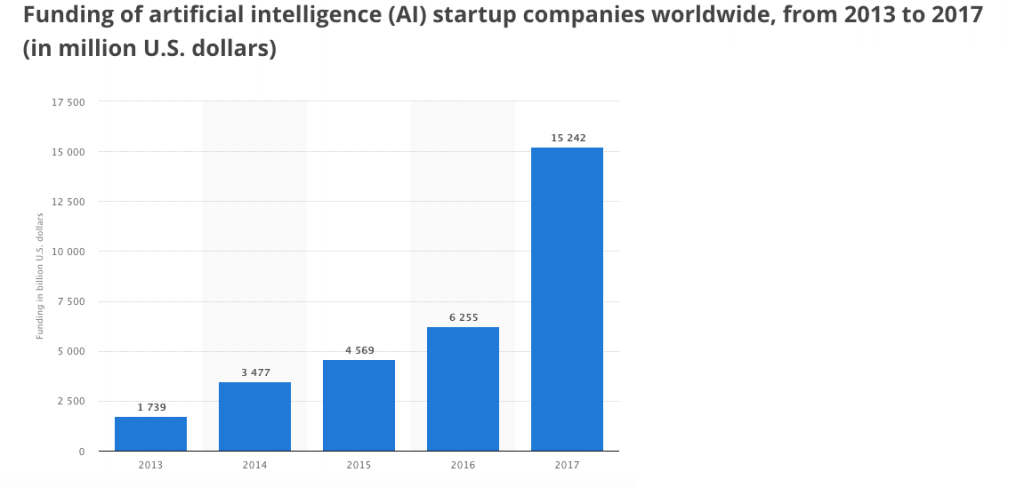
My prediction is that these numbers will continue to trend upward.
Looks like we’re in for a wild, highly-personalized ride in the years to come.




